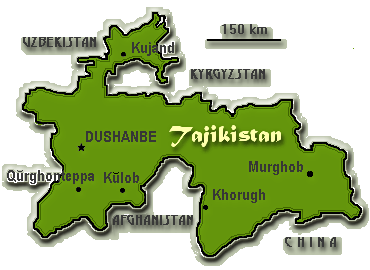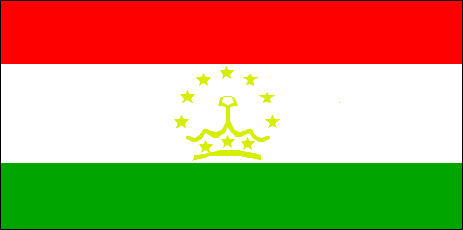Tajikistan

Geography
Location: Central Asia, between Uzbekistan and ChinaArea:
total area: 143,100 sq km
land area: 142,700 sq km
comparative area: slightly smaller than WisconsinLand boundaries: total 3,651 km, Afghanistan 1,206 km, China 414 km, Kyrgyzstan 870 km, Uzbekistan 1,161 km
Coastline: 0 km (landlocked)
Maritime claims: none; landlocked
International disputes: boundary with China in dispute; territorial dispute with Kyrgyzstan on northern boundary in Isfara Valley area; Afghanistan's and other foreign support to Tajik rebels based in northern Afghanistan
Climate: midaltitude continental, hot summers, mild winters; semiarid to polar in Pamir Mountains
Terrain: Pamir and Alay Mountains dominate landscape; western Fergana Valley in north, Kofarnihon and Vakhsh Valleys in southwest
Natural resources: significant hydropower potential, some petroleum, uranium, mercury, brown coal, lead, zinc, antimony, tungsten
Land use:
arable land: 6%
permanent crops: 0%
meadows and pastures : 23%
forest and woodland: 0%
other: 71%Irrigated land: 6,940 sq km (1990)
Environment:
current issues: inadequate sanitation facilities; increasing levels of soil salinity; industrial pollution; excessive pesticides; Tajikistan is part of the basin of the shrinking Aral Sea which suffers from severe overutilization of available water for irrigation and associated pollution
natural hazards : NA
international agreements: NANote: landlocked
People
Population: 5,995,469 (July 1994 est.)
Population growth rate: 2.67% (1994 est.)
Birth rate: 34.79 births/1,000 population (1994 est.)
Death rate: 6.71 deaths/1,000 population (1994 est.)
Net migration rate: -1.43 migrant(s)/1,000 population (1994 est.)
Infant mortality rate: 62 deaths/1,000 live births (1994 est.)
Life expectancy at birth:
total population : 68.76 years
male: 65.88 years
female: 71.79 years (1994 est.)Total fertility rate: 4.62 children born/woman (1994 est.)
Nationality:
noun: Tajik(s)
adjective: TajikEthnic divisions: Tajik 64.9%, Uzbek 25%, Russian 3.5% (declining because of emigration), other 6.6%
Religions: Sunni Muslim 80%, Shi'a Muslim 5%
Languages: Tajik (official), Russian widely used in government and business
Literacy: age 9-49 can read and write (1970)
total population : 100%
male: 100%
female: 99%Labor force: 1.95 million (1992)
by occupation: agriculture and forestry 43%, government and services 24%, industry 14%, trade and communications 11%, construction 8% (1990)
Government
Names:
conventional long form: Republic of Tajikistan
conventional short form : Tajikistan
local long form: Respublika i Tojikiston
local short form: none
former: Tajik Soviet Socialist RepublicDigraph: TI
Type: republic
Capital: Dushanbe
Administrative divisions: 2 oblasts (viloyotho, singular - viloyat) and one autonomous oblast* (viloyati avtonomii); Viloyati Avtonomii Badakhshoni Kuni* (Khorugh - formerly Khorog), Viloyati Khatlon (Qurghonteppa - formerly Kurgan-Tyube), Viloyati Leninobad (Khujand - formerly Leninabad)
note: the administrative center names are in parenthesesIndependence: 9 September 1991 (from Soviet Union)
National holiday: National Day, 9 September (1991)
Constitution: a referendum on new constitution planned for June 1994
Legal system: based on civil law system; no judicial review of legislative acts
Suffrage: 18 years of age; universal
Executive branch:
chief of state : Head of State and Assembly Chairman Emomili RAKHMONOV (since NA November 1992); election last held 27 October 1991 (next to be held NA September 1994); results - Rakhman NABIYEV, Communist Party 60%; Davlat KHUDONAZAROV, Democratic Party, Islamic Rebirth Party and Rastokhoz Party 30%
head of government : Prime Minister Abdujalil SAMADOV (since 27 December 993)
cabinet : Council of Ministers
note: the presidency was abolished in November 1992, when RAKHMANOV became head of state; a referendum on presidential or parliamentary system is planned for June 1994Legislative branch: unicameral
Supreme Soviet: elections last held 25 February 1990 (next to be held NA September 1994); results - Communist Party 99%, other 1%; seats - (230 total) Communist Party 227, other 3Judicial branch: Prosecutor General
Political parties and leaders: Communist Party (Tajik Socialist Party - TSP), Shodi SHABDOLOV, chairman; Tajik Democratic Party (TDP), Shodmon YUSUF; Islamic Revival Party (IRP), Mohammed Sharif HIMOTZODA, Davat OUSMAN; Rastokhez Movement, Tohir ABDUJABBAR; Lali Badakhshan Society, Atobek AMIRBEK
note: all the above-listed parties but the Communist Party were banned in June 1993Other political or pressure groups: Tajikistan Opposition Movement based in northern Afghanistan
Member of: CIS, CSCE, EBRD, ECO, ESCAP, IBRD, IDA, IDB, IMF, INTELSAT (nonsignatory user), IOC, NACC, OIC, UN, UNCTAD, UNESCO, UNIDO, WHO, WMO
Diplomatic representation in US:
chief of mission : NA
chancery: NA
telephone: NAUS diplomatic representation:
chief of mission: Ambassador Stanley T. ESCUDERO
embassy: Hotel October, 105A Rudaki Prospect, Dushanbe
mailing address: use embassy street address
telephone: [7] (3772) 21-03-56 and 21-03-60
Economy
CIA Overview: Tajikistan had the lowest per capita GDP in the former USSR, the highest rate of population growth, and the lowest standard of living. Its economy at the start of 1994 is producing at roughly the 1989 level and faces urgent reconstruction tasks from the 1992 civil war. Tajikistan's economy was severely disrupted by the breakup of the Soviet economy, which provided guaranteed trade relations and heavy subsidies and in which specialized tasks were assigned to each republic. Its economy is highly agricultural (43% of the work force); it has specialized in growing cotton for export and must import a large share of its food. Its industry (14% of the work force) produces aluminum, hydropower, machinery, and household appliances. Nearly all petroleum products must be imported. Constant political turmoil and continued dominance of former Communist officials have slowed the process of economic reform and brought near economic collapse while limiting foreign assistance. Tajikistan is in the midst of a prolonged monetary crisis in which it is attempting to continue to use the Russian ruble as its currency while its neighbors have switched to new independent currencies; Russia is unwilling to advance sufficient rubles without attaching stringent reform conditions.
National product: GDP - purchasing power equivalent - $6.9 billion (1993 estimate from the UN International Comparison Program, as extended to 1991 and published in the World Bank's World Development Report 1993; and as extrapolated to 1993 using official Tajik statistics,which are very uncertain because of major economic changes since 1990)
National product real growth rate: -21% (1993 est.)
National product per capita: $1,180 (1993 est.)
Inflation rate (consumer prices): 38% per month (1993 average)
Unemployment rate: 1.1% includes only officially registered unemployed; also large numbers of underemployed workers and unregistered unemployed people
Budget:
revenues: $NA
expenditures: $NA, including capital expenditures of $NAExports: $263 million to outside the FSU countries (1993)
commodities: cotton, aluminum, fruits, vegetable oil, textiles
partners: Russia, Kazakhstan, Ukraine, Uzbekistan, TurkmenistanImports: $371 million from outside the FSU countries (1993)
commodities: fuel, chemicals, machinery and transport equipment, textiles, foodstuffs
partners: Russia, Uzbekistan, KazakhstanExternal debt: $NA
Industrial production: growth rate -20% (1993 est.)
Electricity:
capacity: 4,585,000 kW
production: 16.8 billion kWh
consumption per capita : 2,879 kWh (1992)Industries: aluminum, zinc, lead, chemicals and fertilizers, cement, vegetable oil, metal-cutting machine tools, refrigerators and freezers
Agriculture: cotton, grain, fruits, grapes, vegetables; cattle, sheep and goats
Illicit drugs: illicit cultivation of cannabis and opium poppy; mostly for CIS consumption; limited government eradication programs; used as transshipment points for illicit drugs from Southwest Asia to Western Europe and North America
Economic aid:
recipient: Russia reportedly provided substantial general assistance throughout 1993 and continues to provide assistance in 1994; Western aid and credits promised through the end of 1993 were $700 million but disbursements were only $104 million; large scale development loans await IMF approval of a reform and stabilization planCurrency: 1 ruble (R) = 100 kopeks; acquiring new Russian rubles as currency under December 1993 agreement
Exchange rates: NA
Fiscal year: calendar year
Communications
Railroads: 480 km; does not include industrial lines (1990)
Highways:
total: 29,900 km
paved: 21,400 km
unpaved : earth 8,500 km (1990)Pipelines: natural gas 400 km (1992)
Ports: none; landlocked
Airports:
total: 58
usable: 30
with permanent-surface runways : 12
with runways over 3,659 m: 0
with runways 2,440-3,659 m : 4
with runways 1,060-2,439 m: 13
note: a C-130 can land on a 1,060-m airstripTelecommunications: poorly developed and not well maintained; many towns are not reached by the national network; 303,000 telephone circuits (December 1991); telephone density about 55 per 1000 persons(1951); linked by cable and microwave to other CIS republics, and by leased connections to the Moscow international gateway switch; Dushanbe linked by INTELSAT to international gateway switch in Ankara; satellite earth stations - 1 Orbita and 2 INTELSAT (one INTELSAT earth station provides TV receive-only service from Turkey)
Defense Forces
Branches: Army (being formed), National Guard, Security Forces (internal and border troops)
Manpower availability: males age 15-49 1,361,143; fit for military service 1,116,246; reach military age (18) annually 57,681 (1994 est.)
Defense expenditures: $NA, NA% of GDP
CIA World Facts (1994)
This page was last up-dated:
